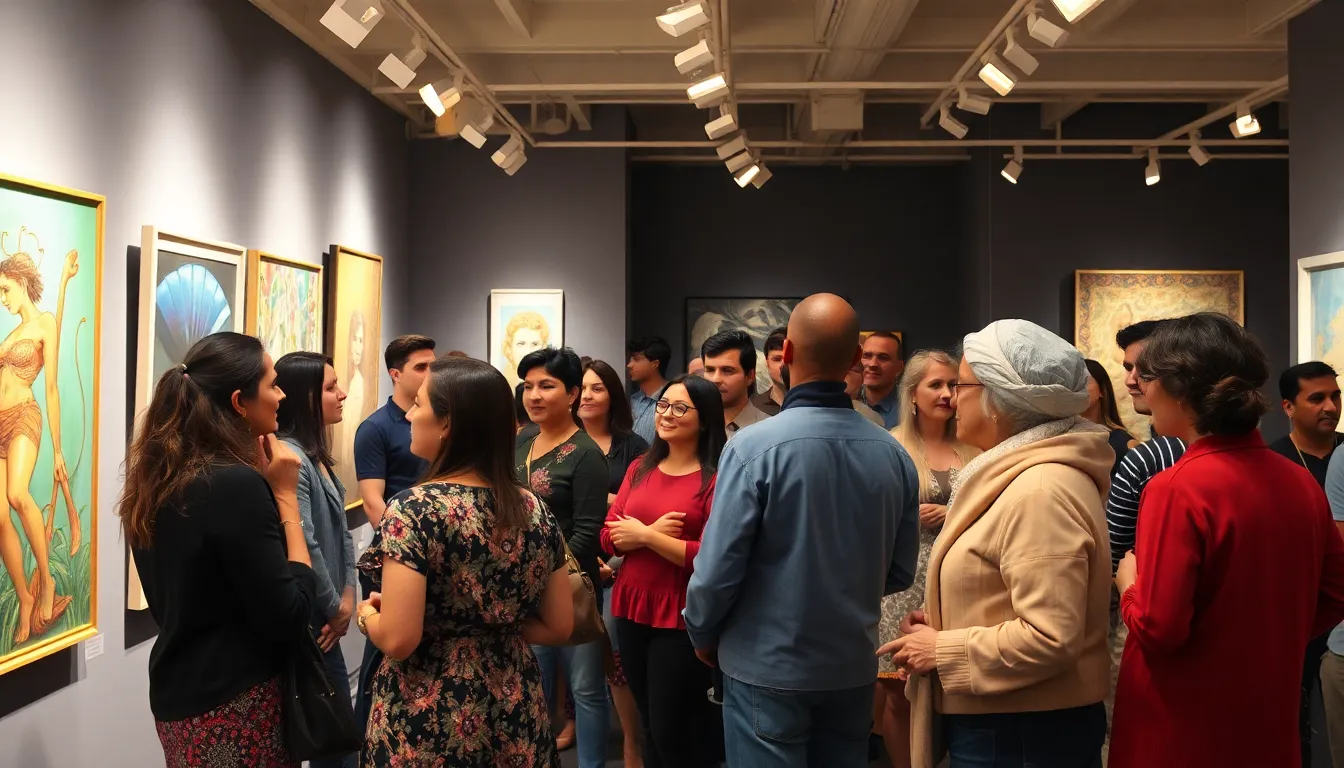Table of Contents
ToggleCultural journalism plays a pivotal role in shaping society’s understanding of art, music, literature, and the myriad expressions of human experience. By delving into the nuances of cultural phenomena, it not only informs but also inspires conversations around identity, tradition, and innovation. As the world becomes increasingly interconnected, the need for insightful cultural commentary has never been more essential.
In a landscape filled with diverse voices and perspectives, cultural journalists serve as bridges, connecting audiences to the stories that matter. They explore the intersections of culture and current events, highlighting the impact of societal changes on creative expression. Through their work, they invite readers to engage with the world around them, fostering a deeper appreciation for the rich tapestry of human culture.
Overview of Cultural Journalism
Cultural journalism encompasses the reporting and analysis of diverse artistic expressions, including visual arts, music, literature, and performance. Journalists in this field examine the intricacies of culture, uncovering trends, movements, and pivotal figures that shape societal values and perspectives.
Cultural journalists assist in understanding identity and tradition by providing critical insights into artistic works and their creators. They spotlight the relationship between art and current events, linking cultural narratives to pressing social and political issues. Through interviews, critiques, and in-depth features, these professionals engage readers with the nuances of cultural phenomena.
Cultural journalism also serves as a platform for marginalized voices. By highlighting underrepresented artists and narratives, it fosters inclusivity and broadens cultural dialogues. These journalists play an essential role in bridging gaps between various communities and facilitating conversations around cultural diversity and intersectionality.
This form of journalism is vital in an interconnected world. It cultivates awareness and appreciation of global cultures. The exploration of local traditions alongside international trends allows audiences to connect with broader human experiences, enhancing their understanding of different customs, beliefs, and innovations.
Importance of Cultural Journalism

Cultural journalism plays a crucial role in society by informing and inspiring individuals through the exploration of diverse artistic expressions. This form of journalism not only enriches cultural understanding but also promotes dialogue about pivotal social issues.
Reflection of Society
Cultural journalism mirrors societal values and concerns. It reflects current events through the lens of art, music, and literature, offering insights into the human experience. Journalists analyze cultural phenomena and respond to public sentiments, contributing to a broader understanding of societal dynamics. By addressing both contemporary and historical contexts, cultural journalism helps audiences recognize the interplay between art and societal change.
Promotion of Diversity
Cultural journalism fosters diversity by amplifying voices from various backgrounds. It emphasizes the importance of underrepresented artists, narratives, and traditions, broadening the scope of cultural discussions. By highlighting diverse perspectives, cultural journalism not only enriches the public discourse but also cultivates a sense of belonging among marginalized communities. This inclusivity ensures a more comprehensive understanding of artistic expressions, reflecting the multifaceted nature of human culture.
Key Elements of Cultural Journalism
Cultural journalism incorporates various elements that enhance its role in the understanding and appreciation of artistic expressions. Two critical aspects include storytelling techniques and ethical considerations, which significantly shape the effectiveness and credibility of cultural reporting.
Storytelling Techniques
Cultural journalism utilizes diverse storytelling techniques to engage audiences with the arts. These techniques include:
- Narrative Structure: Creating a compelling arc to enhance reader interest. This structure often blends personal anecdotes, historical context, and critical analysis.
- Descriptive Language: Employing vivid imagery and detail to bring artistic expressions to life. Descriptive language helps readers visualize performances, artworks, or literary pieces.
- Interviews and Profiles: Highlighting the perspectives of artists to humanize cultural narratives. Direct quotes and personal insights provide authenticity and depth to stories.
- Contextualization: Situating cultural works within larger social or political environments. Contextualization helps readers understand the significance of artistic expressions in relation to contemporary issues.
- Multimedia Integration: Using visuals, audio, and video to enrich storytelling. This approach captivates audiences and allows for a more immersive experience.
Ethical Considerations
Ethical considerations are paramount in cultural journalism to maintain integrity and trust. Key ethical aspects include:
- Accuracy: Ensuring factual representation of artists and their work. Cultural journalists verify information to prevent misrepresentation.
- Inclusivity: Prioritizing diverse voices and perspectives. This commitment helps combat cultural biases and promotes underrepresented narratives.
- Respect for Creative Ownership: Acknowledging the rights of artists and their works. Journalists credit original creators and seek permission where necessary.
- Cultural Sensitivity: Being aware of cultural contexts and implications of artistic expressions. Journalists approach topics with respect and understanding to avoid cultural appropriation.
- Accountability: Taking responsibility for the impact of reporting. Journalists reflect on how their narratives influence public perception of cultures and communities.
Incorporating effective storytelling techniques and adhering to ethical considerations strengthens cultural journalism’s impact, enabling deeper connections between audiences and the arts.
Notable Cultural Journalists and Their Impact
Cultural journalists shape public perception through their influential work. They provide critical analysis of art, music, and literature, impacting discussions around identity and representation. Below are notable cultural journalists and their contributions to the field.
- Robert Christgau: Known as the “Dean of American Rock Critics,” he revolutionized music criticism with his concise, insightful reviews in prominent publications. Christgau’s “Consumer Guide” column set standards for music evaluation, encouraging readers to explore diverse genres.
- bell hooks: A cultural critic and feminist theorist, hooks elevated discussions on race, gender, and culture. Her writings, particularly in “Ain’t I a Woman?” and “Cultural Criticism and Transformation,” critique mainstream culture while advocating for marginalized voices, making her influence profound in cultural journalism.
- Greil Marcus: As an influential music critic and cultural historian, Marcus’s essays delve into the intersection of music and societal change. His book “Mystery Train” explores the impact of American music on culture, demonstrating the power of art to reflect and influence social narratives.
- Sara Marcus: A journalist and author, Sara contributes to discussions around literature and feminism. Her work, especially “Girls to the Front,” highlights the feminist punk movement, showcasing how cultural journalism can document and celebrate underrepresented movements and artists.
- Margo Jefferson: An acclaimed critic and author, Jefferson offers nuanced perspectives on race and culture. Her book “Negroland” combines memoir and cultural analysis, examining the complexities of race and class, making her a vital voice in contemporary cultural discourse.
- David Byrne: The former Talking Heads frontman engages in cultural criticism through writing about art, music, and urban life. His insights bridge the gap between artistic expression and social issues, fostering greater understanding and appreciation of cultural narratives.
- Frida Kahlo: Though primarily known as an artist, Kahlo’s life and correspondence often reflect cultural critiques. Her journal entries provide insight into personal experience and cultural identity, influencing generations of journalists who explore similar themes.
These journalists exemplify the significance of cultural reporting, each contributing unique perspectives that enhance public understanding of art and society. Their work reflects the complexities of human experience, encouraging ongoing dialogues that enrich cultural appreciation.
The Future of Cultural Journalism
Cultural journalism is evolving rapidly, influenced by digital advancements and societal shifts. The landscape is transforming as new challenges and opportunities emerge.
Digital Transformation
Digital transformation reshapes cultural journalism, introducing new platforms for storytelling. Innovations in technology, such as social media, podcasts, and streaming services, expand access to diverse audiences. Journalists leverage multimedia elements, including video and interactive content, to engage readers more deeply. Online publication platforms allow for real-time reporting, enabling immediate audience interaction and feedback. Additionally, data analytics enhance understanding of audience preferences, leading to more tailored content. As cultural consumption increasingly moves online, cultural journalists adapt by developing strategies that embrace these digital tools while maintaining journalistic integrity.
Challenges Ahead
Cultural journalism faces several challenges that impact its future. Funding instability persists as traditional media outlets decrease, leading to fewer dedicated cultural journalism roles. Journalists may prioritize clickbait content due to economic pressures, which can dilute the quality of cultural discourse. Additionally, misinformation and biased reporting pose significant risks, threatening the credibility of cultural narratives. The digital landscape’s saturation requires cultural journalists to distinguish their work, ensuring meaningful conversations around art, identity, and societal issues persist. Cultivating trust through rigorous ethical standards becomes essential for sustaining impactful cultural commentary in an increasingly fragmented media environment.
Cultural journalism stands as a vital thread in the fabric of society. It not only informs but also inspires individuals to engage with diverse artistic expressions. By amplifying underrepresented voices and fostering inclusivity, it cultivates a richer understanding of the complexities surrounding culture.
As this field continues to evolve with digital advancements, the importance of maintaining ethical standards cannot be overstated. Ensuring accuracy and integrity in reporting remains crucial for building trust with audiences. Ultimately, cultural journalism will continue to shape conversations around art and identity, reflecting the dynamic interplay between creativity and societal change.


